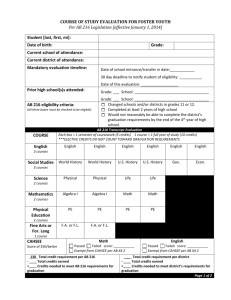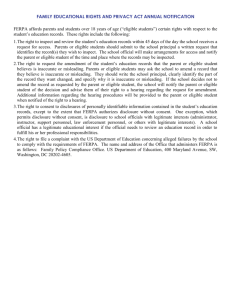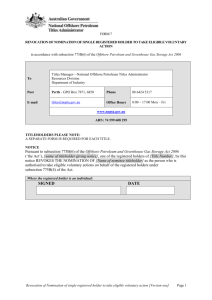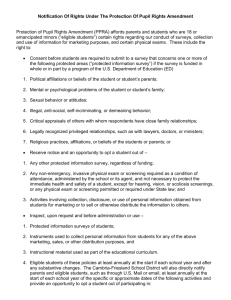Eligible Interest Holder Consent: CER-CFI-EIH
advertisement
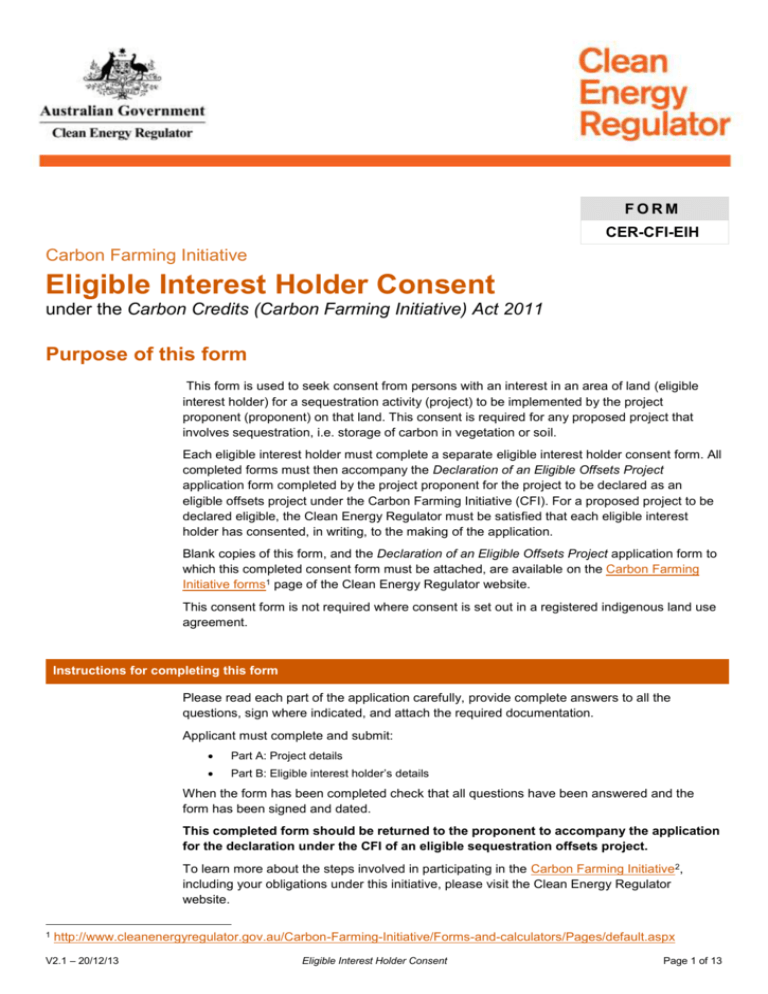
FORM CER-CFI-EIH Carbon Farming Initiative Eligible Interest Holder Consent under the Carbon Credits (Carbon Farming Initiative) Act 2011 Purpose of this form This form is used to seek consent from persons with an interest in an area of land (eligible interest holder) for a sequestration activity (project) to be implemented by the project proponent (proponent) on that land. This consent is required for any proposed project that involves sequestration, i.e. storage of carbon in vegetation or soil. Each eligible interest holder must complete a separate eligible interest holder consent form. All completed forms must then accompany the Declaration of an Eligible Offsets Project application form completed by the project proponent for the project to be declared as an eligible offsets project under the Carbon Farming Initiative (CFI). For a proposed project to be declared eligible, the Clean Energy Regulator must be satisfied that each eligible interest holder has consented, in writing, to the making of the application. Blank copies of this form, and the Declaration of an Eligible Offsets Project application form to which this completed consent form must be attached, are available on the Carbon Farming Initiative forms1 page of the Clean Energy Regulator website. This consent form is not required where consent is set out in a registered indigenous land use agreement. Instructions for completing this form Please read each part of the application carefully, provide complete answers to all the questions, sign where indicated, and attach the required documentation. Applicant must complete and submit: Part A: Project details Part B: Eligible interest holder’s details When the form has been completed check that all questions have been answered and the form has been signed and dated. This completed form should be returned to the proponent to accompany the application for the declaration under the CFI of an eligible sequestration offsets project. To learn more about the steps involved in participating in the Carbon Farming Initiative2, including your obligations under this initiative, please visit the Clean Energy Regulator website. 1 http://www.cleanenergyregulator.gov.au/Carbon-Farming-Initiative/Forms-and-calculators/Pages/default.aspx V2.1 – 20/12/13 Eligible Interest Holder Consent Page 1 of 13 CER-CFI-EIH Project Proponents You must print or obtain a copy of this form for each eligible interest holder. You must then complete and sign Part A of this form before seeking each eligible interest holder’s consent. Eligible Interest Holders You need to complete and sign Part B of this form but you should not do so unless Part A has been completed and signed by the project proponent. Before signing this consent form, it is strongly recommended that all eligible interest holders read and understand the project proposal, and where necessary obtain independent legal advice in relation to providing this consent. In particular, eligible interest holders should understand the implications of permanence obligations and carbon maintenance obligations (CMOs). These obligations have long term implications for the land on which projects take place. See the further information provided below on these obligations. Under the CFI the project proponent is required to have the legal right to carry out the project. This right may include, but is not limited to, having the exclusive carbon rights for the project area. The proponent carries the responsibility for implementing the project in accordance with the Carbon Credits (Carbon Farming Initiative) Act 2011 (CFI Act) and the Carbon Credits (Carbon Farming Initiative) Regulations 2011 (CFI Regulations). The purpose of implementing a CFI project is ultimately to have Australian carbon credit units issued to the proponent, which can be traded in compliance and voluntary carbon markets. Eligible interest holders may also wish to consult the CFI guidance material regarding CFI sequestration projects. Some of this guidance has been provided below. Further information on the scheme, including the CFI Act and CFI Regulations, the methodologies approved for use under the scheme, and other forms and materials are available on the Carbon Farming Initiative3 section of the Clean Energy Regulator website. 2 3 http://www.cleanenergyregulator.gov.au/Carbon-Farming-Initiative/Pages/default.aspx http://www.cleanenergyregulator.gov.au/Carbon-Farming-Initiative/Pages/default.aspx V2.1 – 20/12/2013 Eligible Interest Holder Consent Page 2 of 13 CER-CFI-EIH Pen colours When writing on the form please use a black or blue pen. Check boxes Mark relevant boxes like this with a ✔ or ✘. When an instruction indicates ‘tick’, either ✔ or ✘ is acceptable. Go to Where you see an instruction like this – Go to question 5 – mark the box with a ✔ or ✘ and then go to the question number shown. You need not answer the question(s) in between. Where an instruction has a double arrow (), go to the next indicated part/section. Where an instruction has a single arrow (), go to the next question. Where an instruction has a single arrow pointing down (), fill in the field(s) directly below. Mandatory questions If all fields in a question are mandatory and must be completed, the word in brackets (Required) is added to the end of the question label text. If a field in a question is mandatory only if a condition is met, the words in brackets (If applicable) are added to the end of the question label text. Mandatory fields * This symbol indicates individual mandatory fields that are required to be completed. This symbol indicate an instruction on what to do next. This symbol indicates additional useful guidance to filling in the adjacent field or section. This symbol advises that more than one entry may be required for the section and therefore you may need to photocopy this section. This symbol advises that additional documentation to support a claim may need to be attached to the application. Further guidance Further and separate guidance on completing this form will be made available on the Clean Energy Regulator website. Keep a copy of the completed form and attachments for your records. Help filling in this form If you require assistance filling in the form or have any questions regarding this application process please contact the Clean Energy Regulator general enquiries line on 1300 553 542 or email enquiries@cleanenergyregulator.gov.au. V2.1 – 20/12/2013 Eligible Interest Holder Consent Page 3 of 13 CER-CFI-EIH Part A: Project details A project proponent is the person who is responsible for the eligible offsets project and has the legal right to carry out the project. A proponent can be an individual, a body corporate, a trust, a corporation sole, a body politic (such as a state or territory) or a local governing body. An agent is a person authorised to act on behalf of the project proponent. You must print or obtain a copy of this form for each eligible interest holder. You must then complete and sign Part A of this form before seeking each eligible interest holder’s consent. Name and contact details of the project proponent (Required) Individuals and sole traders should complete question 1a. Non-individuals should complete question 1b. 1a) Proponent’s details – individuals including sole traders (Required) Tick appropriate title, or add other title in the space provided. Title* Mr Mrs Miss Ms Other Add full name details below. Given name * Middle name(s) Family name * For sole traders. (if applicable) Trading name Provide the contact details of the project proponent. Phone number Email address Provide the mailing address of the project proponent. Address* Suburb/City* State* Country* Postcode* V2.1 – 20/12/13 Eligible Interest Holder Consent Page 4 of 13 CER-CFI-EIH 1b) Proponent’s details – non-individual (If applicable) Name of the body corporate, trust, corporation sole, body politic or local governing body. Name * You must provide one of the following: ABN, ACN or ARBN. ABN If the eligible person does not have an ABN, please provide the eligible person’s ACN. ACN If the eligible person does not have an ABN or an ACN, please provide the eligible person’s ARBN. ARBN Name and contact details of the contact person for the organisation stated in question 1b (If applicable) Tick appropriate title, or add other title in the space provided. Title* Mr Mrs Miss Ms Other Add full name details below. Given name * Middle name(s) Family name * Provide the contact details of the project proponent. Phone number Email address Provide the mailing address of the project proponent. Address* Suburb/City* State* Country* Postcode* What is the title of the project? (Required) Provide the title of the project. ROE number V2.1 – 20/12/2013 Eligible Interest Holder Consent Page 5 of 13 CER-CFI-EIH Land title number and location for which the consent is required (Required) Provide the land title number. Land title number Provide the location, including street address where applicable. Location Project proponent’s declaration (Required) This application must be signed by the project proponent. Part 7.4 of the Criminal Code Act 1995 makes it an offence for a person to give information or documentation to a Commonwealth entity if the person providing the information or documentation knows that the information or documentation is false or misleading. The maximum penalty for such an offence is imprisonment up to 12 months. Complete and sign the declaration By signing this request, the signatory declares that he/she has the legal capacity and authority to make this application on behalf of the project proponent named in this form, and declares and acknowledges for and on behalf of the project proponent, that: as the signatory below, I am either the project proponent detailed above or I have the legal capacity and authority to bind the project proponent in respect of the matters contained in this form. all information provided in Part A of this form is complete, true and correct and not misleading by inclusion or omission. the provision of false or misleading information is a serious offence under the Criminal Code Act 1995 and may have consequences under the CFI Act and other laws the project proponent authorises the Clean Energy Regulator to copy, record, use or disclose any of the information provided in relation to this application for the purpose of assessing and making a decision on the application, auditing compliance, enforcement of relevant laws and regulations and for related purposes subject to the requirements of relevant laws, in particular the Privacy Act 1988 and Part 3 of the Clean Energy Regulator Act 2011 Signatory (Required) Name * Signature * Day (dd) Month (mm) Year (yyyy) Signature date * Position in applicant organisation V2.1 – 20/12/2013 Eligible Interest Holder Consent Page 6 of 13 CER-CFI-EIH Part B: Eligible interest holder’s details The eligible interest holder must complete Part B and return this form to the project proponent. This form has 12 pages. You (the eligible interest holder) must receive all 12 pages and the project proponent must fully complete Part A before you complete Part B. It is strongly recommended that you: • • • read the information on pages 10 –12. read and understand the project proposal and where necessary obtain independent advice in relation to providing your consent as an eligible interest holder. check that the project details in Part A of this form have been completed and are correct. Name and contact details of the eligible interest holder (Required) Individuals and sole traders should complete question 6a Non-individuals should complete question 6b 6a) Eligible interest holder’s details – individuals including sole traders (Required) Tick appropriate title, or add other title in the space provided. Title* Mr Mrs Miss Ms Other Add full name details below. Given name * Middle name(s) Family name * For sole traders. (if applicable) Trading name Provide the contact details of the eligible interest holder. Phone number Email address Provide the mailing address of the eligible interest holder. Address* Suburb/City* State* Country* Postcode* V2.1 – 20/12/2013 Eligible Interest Holder Consent Page 7 of 13 CER-CFI-EIH 6b) Eligible interest holder’s details – non-individual (If applicable) Name of the body corporate, trust, corporation sole, body politic or local governing body. Name * You must provide one of the following: ABN, ACN or ARBN. ABN If the eligible person does not have an ABN, please provide the eligible person’s ACN. ACN If the eligible person does not have an ABN or an ACN, please provide the eligible person’s ARBN. ARBN Name and contact details of the contact person for the organisation stated in question 6b (If applicable) Tick appropriate title, or add other title in the space provided. Title* Mr Mrs Miss Ms Other Add full name details below. Given name * Middle name(s) Family name * Provide the contact details of the eligible interest holder. Phone number Email address Provide the mailing address of the eligible interest holder. Address* Suburb/City* State* Country* Postcode* V2.1 – 20/12/2013 Eligible Interest Holder Consent Page 8 of 13 CER-CFI-EIH Eligible interest holder’s declaration (Required) The eligible interest holder must complete and sign this consent. For non-individual interest holders (e.g. a company or body corporate), this consent must be completed and signed by a person who is authorised to bind the eligible interest holder. Part 7.4 of the Criminal Code Act 1995 makes it an offence for a person to give information or documentation to a Commonwealth entity if the person providing the information or documentation knows that the information or documentation is false or misleading. The maximum penalty for such an offence is imprisonment up to 12 months. Complete and sign the declaration By signing this request, the signatory declares that he/she has the legal capacity and authority to make this application on behalf of the applicant named in this form, and declares and acknowledges for and on behalf of the applicant, that: as the signatory below, I am either the eligible interest holder detailed in Part B of this form or I have the legal capacity and authority to bind the eligible interest holder in respect of the matters contained in this form. all information provided in Part B, or in relation to Part B, of this form is, on the basis of reasonable inquiries, complete, true, and correct and not misleading by inclusion or omission. the provision of false or misleading information is a serious offence under the Criminal Code Act 1995 and may have consequences under the CFI Act and other laws any of the information provided in relation to this application may be copied, recorded, used or disclosed by the Clean Energy Regulator for the purpose of assessing and making a decision on the application, auditing compliance, enforcement of relevant laws and regulations and for related purposes subject to the requirements of relevant laws, in particular the Privacy Act 1988 and Part 3 of the Clean Energy Regulator Act 2011 I understand that the proposed eligible offsets project must be maintained for a period of 100 years, if not terminated earlier under the provisions of the CFI Act. I understand that a Carbon Maintenance Obligation (CMO) may be placed over the project area in which I hold an interest during the term of the proposed CFI project. I consent to the application for declaration of the offsets project detailed in Part A of this form. Signatory (Required) Name * Signature * Day (dd) Month (mm) Year (yyyy) Signature date * Position in applicant organisation V2.1 – 20/12/2013 Eligible Interest Holder Consent Page 9 of 13 CER-CFI-EIH Additional information Eligible interst holders Numbers and kinds of eligible interest holders will vary between projects, depending on the nature of the land title and project type. Examples include (but are not limited to): Non-Crown Land Registered legal estate or interest in the land Registered mortgage or charge over any registered legal estate or interest in the land Registered Native Title Body Corporate Crown Land Crown Lands Minister (except in relation to exclusive possession native title land or general law freehold land rights land) Holder of a legal estate or interest, where the estate or interest: – came into existence as a result of a Crown grant (or, was derived from such an estate or interest), or – was created by, or under, legislation (or, was derived from such an estate or interest) Mortgage or charge over any such legal estate or interest Registered Native Title Body Corporate for any native title interest in the land Land Rights Land If lease in force (and lease granted under special legislation for the benefit of Aboriginal people or Torres Strait Islanders), the Minister who administers the legislation If land is held by the Commonwealth (or a Commonwealth statutory authority), the Minister who administers the Aboriginal Land Rights (Northern Territory) Act 1976 or the Act that establishes the statutory authority, as the case may be, otherwise Crown lands Minister (except in relation to freehold land rights land) Registered Native Title Body Corporate for any native title interest in the land Permanence obligation The value of Australian carbon credit units is dependent on whether they are equivalent to, or compensate for, emissions from other sectors. The CFI has been designed to provide consumers with confidence that each carbon credit issued can genuinely offset a tonne of CO2-e emissions. Carbon in vegetation or soils can only offset emissions if it is stored long term. If the carbon was subsequently released back into the atmosphere, for example because vegetation was cleared, it could not offset emissions. For this reason sequestration projects that store carbon in vegetation or soil are subject to permanence obligations. The internationally accepted timeframe to ensure sequestration is equivalent to emissions is 100 years, based on the estimated life of a tonne of CO2-e in the atmosphere. The permanence arrangements for the CFI have been designed to ensure that carbon stored by CFI projects is maintained for at least 100 years, while allowing flexibility to change land uses in the future. Proponents and/or landholders choosing to participate in the CFI do not have to sign a contract with the government committing to maintain carbon for 100 years. Proponents can choose to cancel their project at any time, for example because they wish to sell the land or use it for something else. This would require the relinquishment (handing back) of Australian carbon credit units by the proponent. Proponents wishing to close or revoke a project could choose to purchase credits at the market price and hand those credits back. Alternatively, they could earn credits from another project and hand back those credits instead. CFI sequestration projects may be noted on land titles or relevant land registers to help ensure that anyone buying a property is aware if there is a CFI sequestration project on it. Buyers should consult the Register of Offsets Projects4 to check the type of project, how many credits have been issued, how long the project has been in operation and other details. Example 1 Landholder A has a CFI sequestration project being carried out on their property, for which they are the project proponent. If Landholder A has Australian carbon credit units issued from the project, they are obligated to maintain the carbon on their property for 100 years. Should Landholder A then decide to use 4 http://www.cleanenergyregulator.gov.au/Carbon-Farming-Initiative/Register-of-Offsets-Projects/Pages/default.aspx V2.1 – 20/12/2013 Eligible Interest Holder Consent Page 10 of 13 CER-CFI-EIH the land for a different purpose, Landholder A would have to relinquish those, or equivalent credits, in order to close the project. Example 2 Landholder B granted Proponent X the carbon sequestration rights over a property so that a CFI project could be carried out on the land. When Proponent X submitted the application for the project to be declared eligible under the CFI, Landholder B provided a written consent for the project to be carried out on their land. If Proponent X has Australian carbon credit units issued from the project, they are obligated to maintain the carbon on Landholder B’s property for 100 years. If Landholder B decides to use the land for a different purpose, and Proponent X has been issued with any Australian carbon credit units from the project, Proponent X will have to relinquish those, or equivalent credits, in order to close the project. Natural disturbances If carbon is lost through natural disturbance (e.g. bushfire, drought or disease), action to manage fire (e.g. establishing a fire break) or vandalism, landholders/proponents are not required to return credits. Instead, they must take reasonable action to ensure that carbon stores are re-established. Carbon stores may recover naturally after drought or bushfire with only modest intervention by the proponent, but in some cases active re-establishment or management may be necessary. Proponents will not receive credits while the carbon stores are recovering. Once carbon stores reach and exceed predisturbance levels, credits will start to be issued again. This provides an incentive to manage losses and to reestablish carbon stores as quickly as possible. Proponents are required to maintain the carbon stored in the project over the long term. Proponents will be required to hand back carbon credits if they cause significant reversals in carbon stored by their project, for example, by deliberately clearing vegetation or through mismanagement of the project. Carbon Maintenance Obligations (CMOs) The Clean Energy Regulator may declare that a carbon maintenance obligation applies with respect to an area or areas of land if there is an unmet obligation to relinquish Australian carbon credit units or if the Clean Energy Regulator is satisfied that the person will not comply with the requirement within 90 days. Obligations to relinquish Australian carbon credit units would be triggered if a project declaration is revoked. This might happen if, for example: a project is not properly transferred; carbon stores are deliberately reversed; carbon stores are not re-established following a natural disturbance; or a person provides false or misleading information to the Clean Energy Regulator in relation to the project. A carbon maintenance obligation prevents a person from engaging in conduct that results or is likely to result in a reduction in carbon stores below the benchmark sequestration level, unless the conduct relates to an activity that has been expressly permitted in the declaration. The benchmark sequestration level is the amount of carbon sequestered in the relevant area or areas at the time that the carbon maintenance declaration was made. The carbon maintenance obligation will continue to apply for 100 years after the first Australian carbon credit units were issued for the project or for 100 years after a new project area was added to the project. A carbon maintenance obligation can be revoked once any outstanding relinquishment obligation or penalties payable in relation to the project have been paid in full. Civil penalties will apply if carbon maintenance obligations are breached. Example 3 Landholder A has a CFI sequestration project being carried out on their property, for which they are the project proponent. If Australian carbon credit units have been issued for the project, Landholder A is obligated to maintain the carbon on their property for 100 years. Should Landholder A decide to use the land for a different purpose, they would have to relinquish those, or equivalent credits, in order to close the project. Should Landholder A fail to make the necessary relinquishment, a carbon maintenance order may be imposed their property, preventing them from using the land for a different purpose. Example 4 Landholder B owns a property on which a CFI sequestration project is being carried out by Proponent X. If Australian carbon credit units have been issued for the project, the proponent is obligated to maintain the carbon on Landholder B’s property for 100 years. If Landholder B decides to use the land for a different purpose, and Proponent X has been issued with any Australian carbon credit units from the project, Proponent X will have to relinquish those, or equivalent credits, in order to close the project. Should V2.1 – 20/12/2013 Eligible Interest Holder Consent Page 11 of 13 CER-CFI-EIH Proponent X fail to make the necessary relinquishment, a carbon maintenance order may be imposed on Landholder B’s property, preventing them from using the land for a different purpose. Definitions Person A ‘person’ means any of the following: an individual a body corporate a trust a corporation sole a body politic a local governing body, or Project proponent The ‘project proponent’ is the person who is responsible for carrying out the offsets project, and has the legal right to carry out the project. If the project is a sequestration project the proponent must hold the applicable carbon sequestration right. Seeking legal advice The Clean Energy Regulator provides guidance for general information purposes only. The information in this form and supplied by the Clean Energy Regulator should not be interpreted as independent professional advice. You should not rely solely on this information and should get professional legal advice relevant to your individual circumstances. Protection of information The Clean Energy Regulator is bound by the secrecy provisions of Part 3 of the Clean Energy Regulator Act 2011 (CER Act) in regard to information it collects in relation to this application and also by the Privacy Act 1988 in regard to personal information it collects. Privacy notice 'Personal information' is defined in the Privacy Act 1988 to mean information or an opinion about an identified individual, or an individual who is reasonably identifiable: (a) whether the information or opinion is true or not; and (b) whether the information or opinion is recorded in a material form or not. The collection of personal information relating to this application is authorised by the Carbon Credits (Carbon Farming Initiative) Act 2011 (CFI Act) and the Carbon Credits (Carbon Farming Initiative) Regulations 2011. Personal information collected in relation to this application will be used for the purposes of assessing the application, auditing compliance, enforcement of relevant laws and regulations and for related purposes. We cannot process the application if we do not collect relevant personal information. The Clean Energy Regulator’s Privacy Policy contains information about the agency’s procedures for handling personal information including how a person can access their personal information held by the agency, and how to seek correction of such information. The Privacy Policy also contains information about how to complain about a breach of the Australian Privacy Principles. The Clean Energy Regulator’s Privacy Policy can be found at www.cleanenergyregulator.gov.au. Accessibility disclaimer Whilst the Clean Energy Regulator has worked to ensure this document is accessible, please contact us to obtain an alternative version if you are having difficulty, or you have specific accessibility needs. V2.1 – 20/12/2013 Eligible Interest Holder Consent Page 12 of 13 CER-CFI-EIH Please call 1300 553 542 or email the name of the form and your needs to enquiries@cleanenergyregulator.gov.au Disclosure of Information The Clean Energy Regulator is only able to disclose information relating to this application (including personal information) in accordance with the CER Act, the CFI Act, the Privacy Act 1988 or as otherwise required by law. The circumstances in which such information may be disclosed include: Disclosure to other agencies, persons or organisations to enable the verification of information contained in the application; Disclosure to the Secretary or authorised officer of a Department for the purpose of administering a program or collecting statistics relating to greenhouse gas emissions, energy consumption or energy production; Disclosure to certain agencies, bodies or persons where the Regulator is satisfied that disclosure will enable or assist those agencies, bodies or persons to perform or exercise their functions or powers, including the Australian Securities and Investments Commission, the Australian Competition and Consumer Commission and the Commissioner of Taxation; and Disclosure for the purposes of law enforcement. V2.1 – 20/12/2013 Eligible Interest Holder Consent Page 13 of 13


